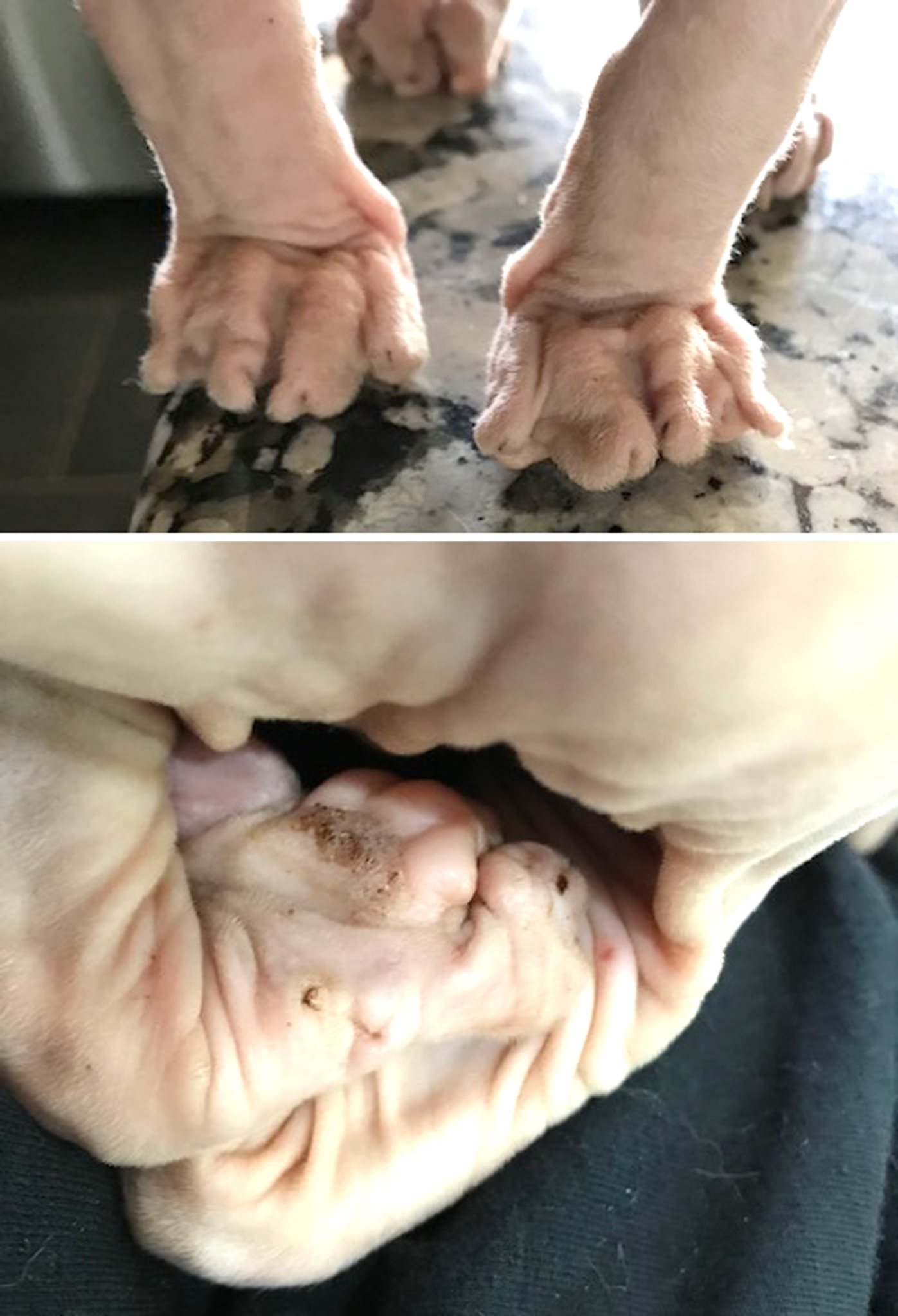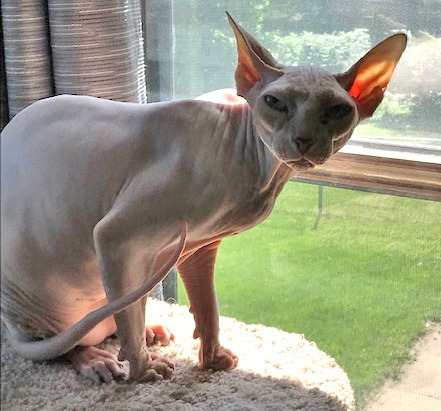Declawing
We Do Not Allow Our Sphynx Kittens To Be Declawed
Please Educate Yourself on Amputation and How Inhumane It Is
***We personally live with 10 adult cats and kittens from our litters. NOTHING in our home is ruined from cats scratching. Its very simple to trim nails every 2-4 weeks and train your kitty to use a scratching post***
Cat declawing is also already illegal in a good swath of Canada and Europe. In the US, a few cities — Los Angeles, San Francisco, and Denver — have already banned the practice. At the state level, Massachusetts and NJ may soon follow New York’s lead; a similar anti-declawing bill is under consideration there.
By ILANA HALPERIN
University of California, Davis 2019
(THE CONVERSATION) -- Declawing a cat might sound as simple as trimming your pet's nails. But it's actually major surgery.
A veterinarian cuts through the joint to amputate part of the cat's toes, from the last knuckle out to the tip of the claw.
Scratching things is a natural behavior for cats. It lets them get healthy stretching exercise and also provides stress relief.
A cat might accidentally scratch you while playing. Or a cat might aggressively lash out with its claws. A pet owner usually chooses onychectomy, as declawing surgery is technically called, to prevent scratching injuries to people or damage to objects.
Declawing will not address the real issue causing a cat to behave aggressively, so the risk of injury from biting remains. One study found that almost 50% of cats occasionally display aggression toward both people they know and strangers.
This surgery comes with risks of complications. Right after being declawed, the cat will be in pain. Vets will prescribe medicine to help manage the immediate pain. There may also be bleeding, swelling and infection.
One study found that 42% of declawed cats had ongoing long-term pain and about a quarter of declawed cats limped. In up to 15% of cases, the claws can eventually regrow after the surgery.
Once a cat is declawed, it must stay indoors only. Removing the claws removes the cat's main way to defend itself and climb well.
Some pet owners see declawing as their last option before getting rid of a cat that scratches. The American Veterinary Medical Association "strongly encourages" people to learn more about the procedure before signing a cat up. It's possible an owner might not understand normal scratching behavior or how serious the surgery is.
Many veterinarians, including me, do not perform declawing surgery. In most cases it's because they feel the elective procedure is not medically necessary and that it's not a humane choice for cats.
Declawing is illegal in some American cities, including Los Angeles and Denver, and the state of New York. The U.K., Australia and many parts of the European Union and Canada have also outlawed declawing.
If you have a cat that just won't stop scratching, there are some other solutions. Frequent nail trimming and the use of plastic nail caps over the cat's claws can help. Offering scratching posts and spray posts with cat nip spray and other forms of environmental enrichment can also reduce scratch damage. Double sided tape on areas that the cat scratches is also a great deterrent. Veterinarians can prescribe therapies to reduce feline anxiety, too, including medications and pheromone diffusers that spread calming chemicals that cats naturally release.
Living with a cat comes with the responsibility to keep that pet healthy and content. That means finding a fair balance between protecting the health of family members and that of the household cat. It may also mean coming to terms with the idea that some cats express their normal need to scratch on the furniture. Fortunately, veterinarians are available to discuss options to keep everyone in the household comfortable and happy.
Understanding Declawing (Onychectomy)
The anatomy of the feline claw must be understood before one can appreciate the severity of declawing. The cat’s claw is not a nail as is a human fingernail, it is part of the last bone (distal phalanx) in the cat’s toe. The cat’s claw arises from the unguicular crest and unguicular process in the distal phalanx of the paw (see above diagram). Most of the germinal cells that produce the claw are situated in the dorsal aspect of the ungual crest. This region must be removed completely, or regrowth of a vestigial claw and abcessation results. The only way to be sure all of the germinal cells are removed is to amputate the entire distal phalanx at the joint.Contrary to most people’s understanding, declawing consists of amputating not just the claws, but the whole phalanx (up to the joint), including bones, ligaments, and tendons! To remove the claw, the bone, nerve, joint capsule, collateral ligaments, and the extensor and flexor tendons must all be amputated. Thus declawing is not a “simple”, single surgery but 10 separate, painful amputations of the third phalanx up to the last joint of each toe. A graphic comparison in human terms would be the cutting off of a person’s finger at the last joint of each finger.
Many vets and clinic staff deliberately misinform and mislead clients into believing that declawing removes only the claws in the hopes that clients are left with the impression that the procedure is a “minor” surgery comparable to spay/neuter procedures and certainly doesn’t involve amputation (partial or complete) of the terminal-toe bone, ligaments and tendons. Some vets rationalize the above description by saying that since the claw and the third phalanx (terminal toe bone) are so firmly connected, they simply use the expression “the claw” to make it simpler for clients to “understand”. Other vets are somewhat more honest and state that if they used the word “amputation”, most clients would not have the surgery performed! Onychectomy in the clinical definition involves either the partial or total amputation of the terminal bone. That is the only method. What differs from vet to vet is the type of cutting tool used (guillotine-type cutter, scalpel or laser).
Complications
Declawing is not without complication. The rate of complication is relatively high compared with other so-called routine procedures. Complications of this amputation can be excruciating pain, damage to the radial nerve, hemorrhage, bone chips that prevent healing, painful regrowth of deformed claw inside of the paw which is not visible to the eye, and chronic back and joint pain as shoulder, leg and back muscles weaken.
Other complications include postoperative hemorrhage, either immediate or following bandage removal is a fairly frequent occurrence, paw ischemia, lameness due to wound infection or footpad laceration, exposure necrosis of the second phalanx, and abscess associated with retention of portions of the third phalanx. Abscess due to regrowth must be treated by surgical removal of the remnant of the third phalanx and wound debridement. During amputation of the distal phalanx, the bone may shatter and cause what is called a sequestrum, which serves as a focus for infection, causing continuous drainage from the toe. This necessitates a second anesthesia and surgery. Abnormal growth of severed nerve ends can also occur, causing long-term, painful sensations in the toes. Infection will occasionally occur when all precautions have been taken. CATS DO NOT SHOW PAIN. Most feel pain in their feet for the rest of their lives. Therefore become aggressive and stop using the litterbox.
“
It's disturbing to know that declawing vets are ruining the lives of so many healthy cats like Fluffy.
Enough is enough folks! This animal cruelty needs to end!
My name is Fluffy and I am approximately 8 years old. I was recently dumped at a local shelter for being mean to kids and litter box problems. From tracing my microchip I have had at least 3 owners and I bet if you are looking at my pics you can see why.
I am currently living with a family that has fostered for over 20 years and who have rescued numerous nekkid kittehs like myself in the past.
They told me about Chico who they lost last year who had arthritis in his legs and back that the vet said was from declawing. He also had seizures and other issues but they gave him a good last few years.
They promised me they could try to do the same and I wish that was all the pain I had. My declaw was SO bad that my front leg has bent over time, from the way I walk.
I also have stretched the tendons in my front feet so badly that my feet hyper-extend becoming dislocated and my new family have to massage them back in to place.
I am trying out new pain meds and supplements and alternative litter boxes such as a super low sided box.
They say that my quality of life is important and they hope some of these things work for me because right now I gotta tell you it sucks.
PLEASE STAND UP TO DECLAWING! Lets pray more states like NY make it ILLEGAL TO DECLAW YOUR CATS!



